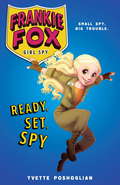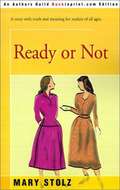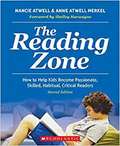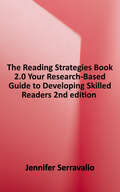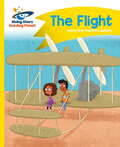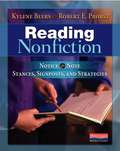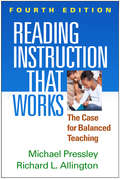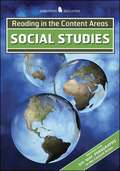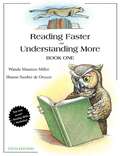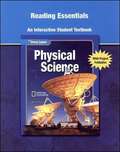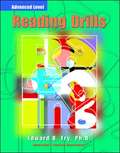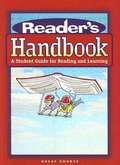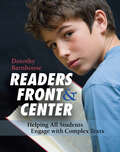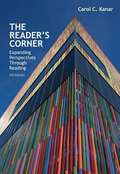- Table View
- List View
Ready, Set, Spy
by Yvette PoshoglianSmall spy. Big trouble.Frankie Fox thinks she's just a regular 11-year-old girl.She loves hanging out with her best friend, playing with her dog, solving puzzles and reading stories about secret agents. But then Frankie discovers something amazing: someone is secretly training her to be a spy!When Frankie's billionaire inventor dad is kidnapped by the mysterious and evil group known as the Alliance, it's time for her to put her spy skills to work. It's a big first assignment for a small spy. Can she solve the mind-bending puzzles? Work out the head-spinning gadgets?Is Frankie ready to save her dad?READY, SET, SPY is the first book in the completely addictive Frankie Fox, Girl Spy series. Stay tuned for her next adventure.Visit the author at yvetteposhoglian.com or facebook.com/yvetteposhoglianauthor or follow her on twitter.com/yvetteposh
Ready or Not (Morgan Connor Stories, #1)
by Mary StolzMorgan, Julie, and Ned Connor and their father Dan live in New York City. A poor family, they constantly have to move from one building to another to make ends meet. Morgan, the oldest at sixteen, cares for the rest of the family, escaping sometimes from her many responsibilities by daydreaming of a mysterious boy she might meet one day. When the family moves this time, however, Morgan meets a young man, Tom Miller, not realizing that she will fall in love with him. This novel follows the slow groth of Morgan and Tom's friendship and also looks at the two younger children, Ned and Julie, and at Dan's hard and frustrating life. He is an intelligent and poetically inclined man who works in a subway station. Written in the 1950's, this story is somewhat grittier and less lighthearted than many others of its day, but it also has hope and some optimism. A second book, The Day and the Way We Met, follows this one.
Ready, Mathematics Practice and Problem Solving [Grade] 8
by Ron Larson Laurie BoswellNIMAC-sourced textbook
The Reading Zone: How To Help Kids Become Passionate, Skilled, Habitual, Critical Readers
by Nancie Atwell Ann Atwell MerkelDecades of expert teaching and thoughtful observation of readers inform this expanded second edition of The Reading Zone. Dynamic teaching and writing partners, mother and daughter Atwell and Atwell Merkel show how to teach reading as a personal art―a way to develop passionate, critical readers for life―and how to build a schoolwide reading culture on self-selected, voluminous reading. The authors describe the top ten conditions for making engaged classroom reading possible for students at all levels and share the ideas and structures that have helped their own students succeed.
Reading Street
by The Editors at the Pearson EducationA comprehensive collection of literature from various genres that tries to enhance the joy of reading.
The Reading Strategies Book 2. 0: Your Research-Based Guide to Developing Skilled Readers
by Jennifer SerravalloEvidence-based, responsive instruction made easier. - 100 new and 200 heavily revised strategies - 700+ references or links to research studies - Skill progressions for progress monitoring - 200 new student-facing charts - New strategies for advanced middle school readers - Recently published mentor texts used in lesson examples Serravallo brings a practical and proven approach to helping teachers help kids develop as skilled readers. The Reading Strategies Book 2.0 is designed to work in every K-8 classroom, providing strategies and lesson plans for every type of reader. The user-friendly design of The Reading Strategies Book 2.0 makes it easy to find strategies, prompts, and tips that meet every student where they are now. Save prep time and support readers' progress toward skills mastery with classroom-ready features such as revised lesson language with updated mentor texts, teaching tips with advice for differentiation, and mostly new student-facing charts. Whether you are looking for powerful and engaging lessons for whole-class teaching, need to supplement your core curriculum with small-group instruction, want to improve the quality of content-area instruction, or need ideas for intervention, The Reading Strategies Book 2.0 will help you connect research to practice.
Reading Planet - The Flight - Yellow: Comet Street Kids
by Adam Guillain Charlotte GuillainComet Street Kids reading books follow the adventures of Rav, Asha, Tess and Finn, four of the residents of Comet Street. There are 72 exciting stories in the series that children won't be able to put down. Rav and Asha are enjoying looking at old transport in the museum when they get transported back in time! They meet people who are trying to fly ? but no one is very good. Can Rav and Asha help the Wright brothers fly their plane for the first time? Reading age: 5-6 years
Reading Nonfiction: Notice and Note Signposts and Questions
by Kylene Beers Robert E. Probst"When students recognize that nonfiction ought to challenge us, ought to slow us down and make us think, then they're more likely to become close readers." That means we need to help them question texts, authors, and, ultimately, their own thinking. No matter the content area, with Reading Nonfiction's classroom-tested suggestions, you'll lead kids toward skillful and responsible disciplinary literacy. <P><P> Picking up where their smash hit Notice & Note left off, Kylene Beers and Bob Probst write: "Fiction invites us into the writer's imagined world; nonfiction intrudes into ours and purports to tell us something about it." This crucial difference increases the responsibility of the nonfiction reader, so Kylene and Bob have developed interlocking scaffolds that every student can use to go beyond a superficial reading: <P><P> <li>3 essential questions that set students up for closer, more attentive readings of nonfiction texts <li>5 Notice & Note nonfiction signposts that cue kids to apply the skills and processes that sophisticated readers use instinctively <li>7 proven strategies readers can use to clear up confusions when the text gets tough. <P><P> We all know the value of helping students define nonfiction and understand its text structures. Reading Nonfiction goes the next crucial step-helping kids challenge the claims of nonfiction authors, be challenged by them, and skillfully and rigorously make up their mind about purported truths.
Reading Instruction That Works, Fourth Edition: The Case for Balanced Teaching
by Michael Pressley Richard L. AllingtonThis widely adopted text and K-8 practitioner resource demonstrates how successful literacy teachers combine explicit skills instruction with an emphasis on reading for meaning. Distinguished researcher Richard L. Allington builds on the late Michael Pressley's work to explain the theories and findings that guide balanced teaching and illustrate what exemplary lessons look like in action. Detailed examples offer a window into highly motivating classrooms around the country. Comprehensive in scope, the book discusses specific ways to build word recognition, fluency, vocabulary, and comprehension, especially for readers who are struggling. New to This Edition *Updated throughout to reflect important recent research advances. *Chapter summing up the past century's reading debates and the growing acceptance of balanced teaching. *New and revised vignettes of exemplary teachers.
Reading in the Content Areas: Social Studies
by McGraw-Hill Education StaffBased on the best-selling Six-Way Paragraphs books, these individual titles help students master the essential skills needed to organize, understand, and apply information in math, science, and social studies. Here are the books that will open doors for you into your content area classrooms.
Reading Faster and Understanding More
by Wanda Maureen Miller Sharon Steeber De OrozcoThe Reading Faster, Understanding More developmental workbooks recognize the inseparable links between comprehension, vocabulary and reading rate. With vocabulary and study skills instruction integrated throughout, each chapter guides students through the reading comprehension and rate improvement processes and includes exercises to practice these skills. Book 1 features lively readings-from the 6th to 8th grade level--on the Fry test, with the "textbook" chapter at the 9th grade level. For anyone interested in reading comprehension.
Reading Essentials for Life Science
by Glencoe ScienceUnit 1. Life's structure and function -- Unit 2. From bacteria to plants -- Unit 3. Animal diversity -- Unit 4. Human body systems -- Unit 5. Ecology --
Reading Essentials for Glencoe Physical Science: An Interactive Student Workbook
by McGraw-HillReading Essentials, Student Edition provides concise content of the Student Edition written at a lower grade level, making it perfect for struggling readers and ELL students.
Reading Essentials: Earth and Space Science
by Mcgraw Hill EducationReading Essentials takes the stress out of reading, learning, and understanding science. This book covers important concepts in science, offers ideas for how to learn the information, and helps you review what you have learned.
Reading Essentials: An Interactive Student Workbook Earth Science
by National GeographicReading Essentials for Earth Science: In today's world, knowing science is important for thinking critically, solving problems, and making decisions. But understanding science sometimes can be a challenge. Reading Essentials takes the stress out of reading, learning, and understanding science. This book covers important concepts in science, offers ideas for how to learn the information, and helps you review what you have learned.
Reading Drills Advanced Level (Reading Drills)
by Edward B. FryReading Drills is a three-level series, with classic and contemporary fiction and nonfiction readings, designed to teach students how to improve their reading speed while building valuable comprehension and critical thinking skills.
Reading Comprehension
by Hancock Lisa Richert Jean Brittenum MollieThis collection of fascinating readings with follow-up activities is designed to be an effective tool for developing comprehension and vocabulary skills. The follow-up activities encompass such basic skills as author's purpose, fact or opinion, skimming, reading for details, vocabulary, compare/contrast, time sequence, main idea, referents, and many more. An extension activity is also provided with each reading to be used for enrichment or as a "challenge" for those who finish early.
Reading and Note Taking Guide Level A: Focus on California Life Science
by Pearson Prentice HallThis Reading and Note Taking Guide helps students succeed in their study of science. Working through the exercises will help them understand and organize the concepts presented in the textbook. The completed worksheets then become easy-to-follow study guides for test preparation.
Reader's Handbook: A Student Guide for Reading and Learning
by Laura Robb Ron Klemp Wendell Schwartz Mike Mcconnell Phil LaleikeNIMAC-sourced textbook
Readers Front and Center: Helping All Students Engage with Complex Text
by Dorothy BarnhouseEvery teacher wants and expects his or her students to be reading increasingly complex texts, yet sometimes the gap between our expectations and our students' abilities seems wide and deep. It's tempting to look at that gap and step in to fill it for them, but then we'd be doing most of the heavy lifting the understanding, analysis, and interpretation that our students should be learning for themselves. So how can teachers reverse this trend and ensure that our students are fully entering, absorbing, and experiencing texts? How can we make sure they're making complex meaning independently and proficiently,- as the Common Core State Standards require? Readers Front & Center answers these questions by framing instruction that starts with the student. You'll learn how to do the following: Research and listen to your students so your teaching can be more targetedNotice and name your students' thinking so they can see- what complex thinking looks and sounds likeSet your students up to be problem solversPrepare your students to do increasingly complex thinking in increasingly complex texts Filled with examples of one-on-one conferences, small groups, and whole-class scenarios, this essential book provides an accessible and inspiring model of how-;and why-;we need to put students at the front and center of our teaching.
The Reader's Corner: Expanding Perspectives Through Reading (Fifth Edition)
by Carol C. KanarWritten for the upper-level developmental courses, THE READER'S CORNER features compelling reading selections and strategies that build strong critical-thinking and analytical skills. The readings vary in length and reflect a range of sources, from the Associated Press to the works of authors such as Shankar Vedantam, Caroline Hwang, Donna Brazile, and Leonard Pitts. Longer selections allow students to apply new skills and strategies to material similar to what they will encounter in other college courses. Unlike traditional texts that teach reading skills through "skill and drill" exercises, THE READER'S CORNER inspires students to think critically about what they read by offering a more authentic reading experience. The fifth edition presents refocused themes in Part 2, "Changing Times," and Part 5, "Life and Work in a Digital Age," and a new pair of readings in each part that look closely at opposing viewpoints on a topic. A robust pre- and post-reading apparatus accompanies each selection and helps build students' vocabulary, critical-reading, and critical-thinking skills.
The Reader's Anthology
by Robert PotterClassic and contemporary works by authors such as Maya Angelou, Laura Ingalls Wilder, Langston Hughes, and Robert Frost help students comprehend and enjoy fiction, nonfiction, poetry, and drama. In addition, each book has a controlled reading level and a strong vocabulary strand. Reading Level: 5-9 Interest Level: 6-12
